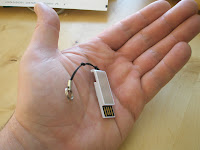 I recently bought this tiny 2GB USB stick. It's an Advent Slider (I think), and it cost £12 from PC World, which seemed like a reasonable price, even though I was in PC World.
I recently bought this tiny 2GB USB stick. It's an Advent Slider (I think), and it cost £12 from PC World, which seemed like a reasonable price, even though I was in PC World.It comes with a little cord to attach to your keyring, and as it only weighs 2-3g (according to my kitchen scales) it's light enough to actually carry around on your keyring without you actually noticing you've got it with you.
As the name Slider suggests the bottom of the device slides out to make a USB connector, slightly narrower than the overall width of a USB port. Which is nice because, as well as being 8 times smaller capacity than this one, my current USB stick blocks the adjacent USB port on my laptop when it is plugged in.
 The only niggle is the normal one when you buy mass storage devices. Which is that mass storage manufacturers insist on specifying capacities of their devices as if 1GB was 1,000,000,000 bytes, whereas computers are programmed to think 1GB is 1,073,741,824 bytes (= 1024 × 1024 × 1024). So when you select 2GB of photos and drag them to the stick, they don't actually fit. The actual capacity of this stick is 2,021,654,016 bytes (raw) and 2,021,621,760 (FAT32 formatted as packaged), which is technically 1.88GB.
The only niggle is the normal one when you buy mass storage devices. Which is that mass storage manufacturers insist on specifying capacities of their devices as if 1GB was 1,000,000,000 bytes, whereas computers are programmed to think 1GB is 1,073,741,824 bytes (= 1024 × 1024 × 1024). So when you select 2GB of photos and drag them to the stick, they don't actually fit. The actual capacity of this stick is 2,021,654,016 bytes (raw) and 2,021,621,760 (FAT32 formatted as packaged), which is technically 1.88GB.I have to say that for the layman [1], I think that it does make more sense for 1GB = 1e9 bytes (and likewise, 1MB = 1e6 bytes and even 1KB = 1000 bytes), and it makes it easy to look at the byte count of a chunk of data and translate it easily into the appropriate units by just taking the correct prefix of the base 10 amount. The only drawback is that it flies in the face of many years of computer science teaching.
Of course the situation we are in at the moment, where computers report base 2 units and mass storage manufacturers artificially inflate the capacity of their products by quoting unformatted base 10 units, is the worst of both worlds. But I don't expect it to improve any time soon. Even worse is the idea of introducing a parallel series of units (kibibytes, mebibytes, gibibytes) to compound the confusion.
Anyway, I've been carrying it around on my keyring since I got it. I've not used it for anything interesting yet, but when I need it it will be there.
[1] layman/lame-man is an example of an eggcorn. As in "to put it in lame-man's terms". Read more about eggcorns at The Eggcorn Database.